Travis Pike

The Marine Corps is rolling into the future, stripping armor assets, and streamlining their approach to warfare. The Marine Rifle Squad, in particular, has seen a unique update that’s changed its basic composition from 13 Marines to 15 Marines. Besides adding two Marines to the squad, their arsenal has also been updated with lighter, more lethal weapon options. In part 2 of our analysis of the Future of the Marine Corps Rifle Squad, we are taking a peek at their new arsenal.
The Marine Rifle Squad has made four changes to its weaponry loadout. These changes streamlined the squad’s firepower and gave the basic rifle squad better capabilities for modern warfare. The focus seems to be on making the individual squad more autonomous and more capable, which aligns with the structure update of the Marine Rifle Squad.
 (U.S. Marine Corps photo by Lance Cpl. Emma L. Gray)
(U.S. Marine Corps photo by Lance Cpl. Emma L. Gray)M27 IAR
Infantry forces in the United States Marine Corps have universally adopted the M27 IAR. Gone are the M4s and M16A4s, which dominated the squad back in my day. IAR stands for infantry automatic rifle, and the original intent was to replace the M249 SAW with a lightweight weapon that utilized the same standard magazines as the M4 and M16A4 series.
 (U.S. Marine Corps photo by Sgt. Brandon L. Saunders/released)
(U.S. Marine Corps photo by Sgt. Brandon L. Saunders/released)However, in a rather sneaky move, the Marine Corps went on to fully adopt the M27 IAR for infantry forces. I was doubtful that the IAR could replace the firepower of a belt-fed weapon, but with an entire Marine Rifle Squad wielding IARs, it might just be possible. The M27 is from HK and provides an extremely accurate and reliable platform.
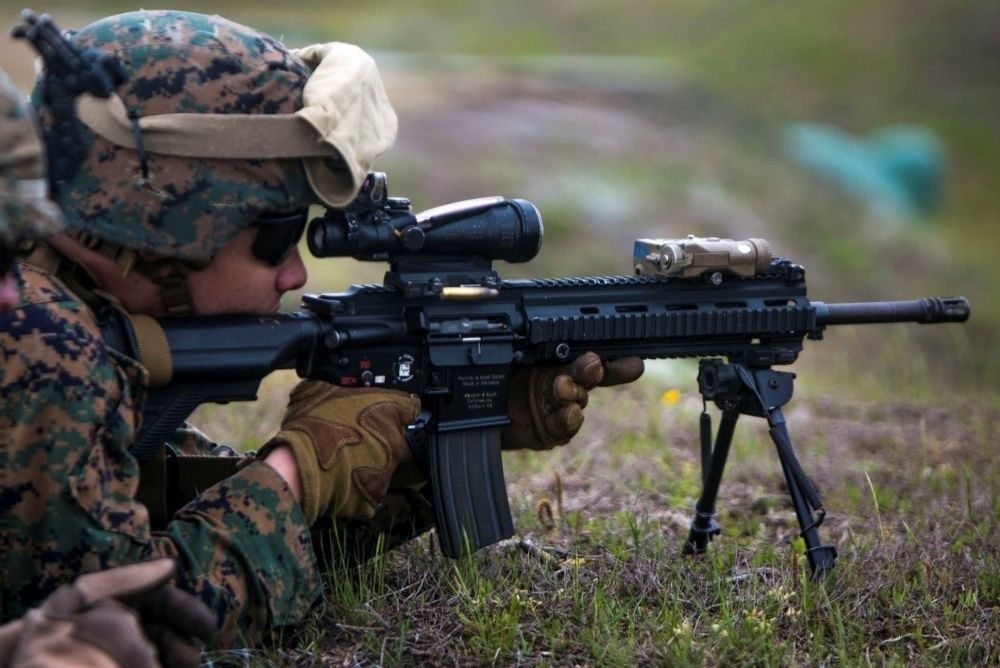
The future M27 rifles will be outfitted with an LPVO from Trijicon, which will give every Marine a 1-8X optic for both close and long-range precision. Additionally, the Marine Corps plans to issue suppressors to every Marine. These suppressors will improve communication, potentially protect the hearing of the Marines, and make the Marines harder to target. Marines responsible for using the IAR as an automatic rifle will also be rocking a bipod.
The M38 SDMR
The M27 proved to be quite accurate, and as such, it was adopted into the squad-designated marksman role (SDMR) as well. Each Marine Rifle Squad will have at least one SDMR rifle. The main difference between the M27 and M38 will be the addition of a more powerful optic. Marines equipped with the SDMR use the Leupold TS-30A2 Mark 4 MR/T that provides a magnification range of 2.5-8X.
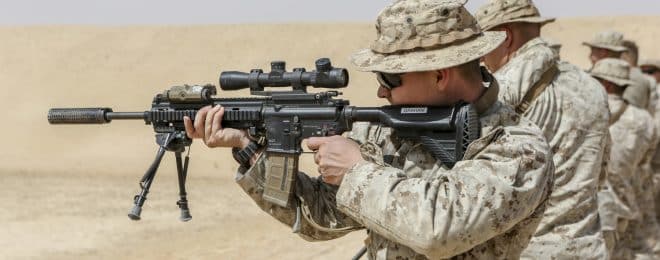
The M38 will also be equipped with a bipod and sound suppression device. Bipods will stabilize the rifle and allow you to easily engage targets at ranges beyond the norm. SDMRs will also allow Marines to engage small targets at close to moderate ranges.
Targets hiding behind cover, in particular, can be difficult to hit. The squad designated marksman’s rifle proved to be a valuable concept for Marines in combat, as it allows for greater opportunities to score hits under those circumstances.
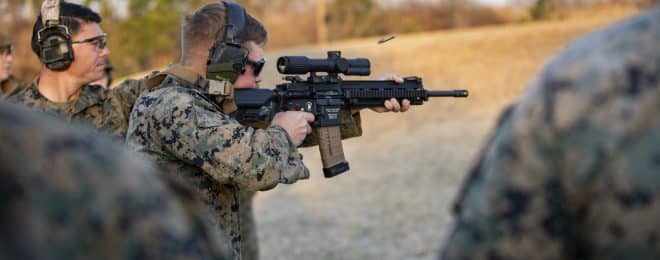
Its ability to reach out over long distances allows the Marine squad to expand its overall range while providing a very accurate weapon for a variety of engagements. When the Marine Rifle Squad is in the ambush, the M38 ensures an accurate first shot for the ambush to begin. In combat, the M38 will be perfect for providing accurate fire but will still be a lightweight carbine that excels at close quarters combat.
The M320
The Marine Rifle Squad ditched the M230 in favor of the M320. While it just seems like an anagram of the ole’ M203, the M320 offers Marines a far more capable grenade launcher. The M320 is a single shot, 40mm grenade launcher capable of utilizing everything from High Explosive Dual Purpose (HEDP) to smoke and tear gas rounds. The M320 will be in the hands of the rebooted grenadier role.
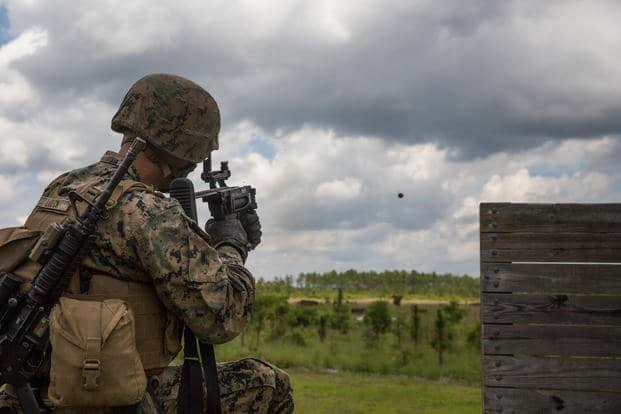
Grenadiers in the Marine rifle squad can send 40mm flying out to 350 meters on an area target. This capability allows Marines to engage targets behind cover and deliver long-range explosives on demand. Grenade launchers and machine guns were the most valuable weapons in a firefight, from my experience.
Fireteam leaders used to serve a dual purpose as a grenadier, but that role will now go to a rifleman in the squad. The M320 differs from the M203 by being a standalone weapon. The M203 is permanently affixed to the M4, while the M320 can be attached to a rifle, but doesn’t require it.

The advantages of a standalone system are numerous. First, it ensures the Marines rifle is lighter and much easier to use. Just as importantly, a standalone launcher is much easier to use than one attached to a rifle. The light design of the M320 is also easier to aim and faster to reload than its predecessors. It’s much less clumsy than a rifle-attached launcher.
Also, should the team leader need to mark an area with smoke, the grenade launcher can be passed to him. The same goes if the grenadier in injured. Instead of passing off both a rifle and launcher, he can pass off just the launcher.
The M3E1 MAAWS
The Marine Corps is ditching the classic Assaultman MOS (Military Occupational Specialty). Assaultmen were company-level demolition and anti-armor experts skilled with numerous explosives and the SMAW rocket launcher. With the Marine Corps eliminating the MOS, the anti-armor role is going back to the Marine rifle squad with the M3E1 MAAWS.
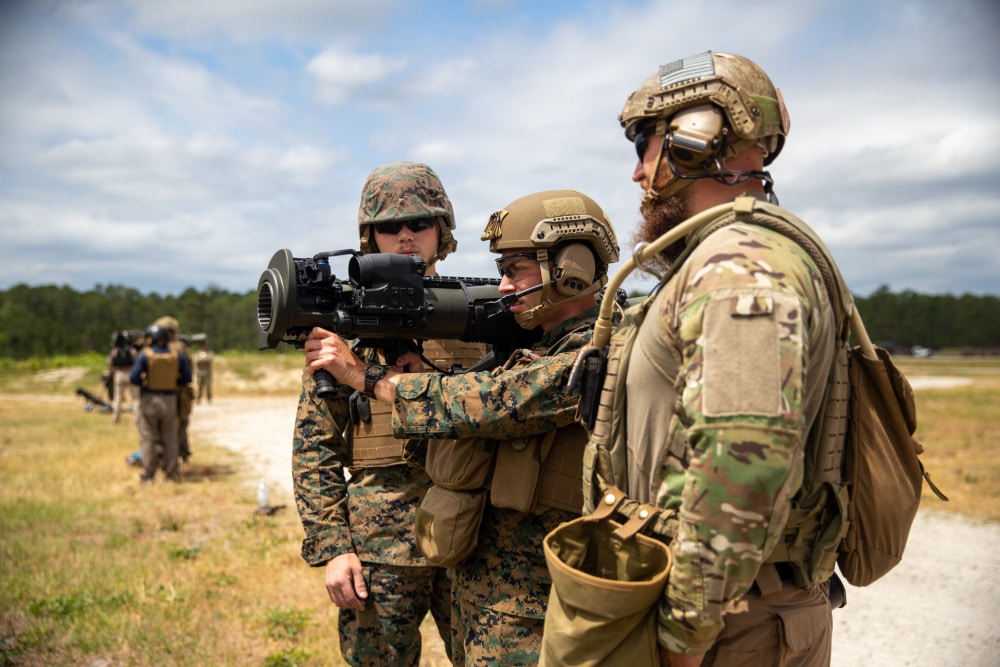
The M3E1 MAAWS has been in use with the Army for years, and it’s proven to be a capable and easy-to-launch recoilless rifle. MAAWS stands for Multipurpose Anti-Armor Anti-Personnel Weapon System, and it fires an 84mm rocket capable of reaching out to 800 meters. The SMAW was not a beloved weapon. It was clumsy, unreliable, and the target rifle it wore sucked.
The MAAWS is a bit lighter than the SMAW and comes with a fire control system with ballistic solutions for engaging moving targets that factor in meteorology. The Marine rifle squad will carry a single MAAWS, and this provides excellent anti-armor and anti-bad-guys-hiding-in-buildings capabilities.
The Future of Island Hopping
With Marines going back to their naval roots and potentially preparing for an island-hopping campaign in the Pacific, these changes make sense. A lighter force that is capable of doing long-range patrols allows the Marine squad to take on a wide variety of tasks. With a littoral regiment now stood up and the loss of organic artillery and tanks, the Marine Corps is clearly planning for a more streamlined force.
Streamlined, of course, doesn’t need to mean a loss of lethality, and clearly, the Marines are maintaining a focus on combat effectiveness and lethality with its structural and arsenal changes.
No comments:
Post a Comment